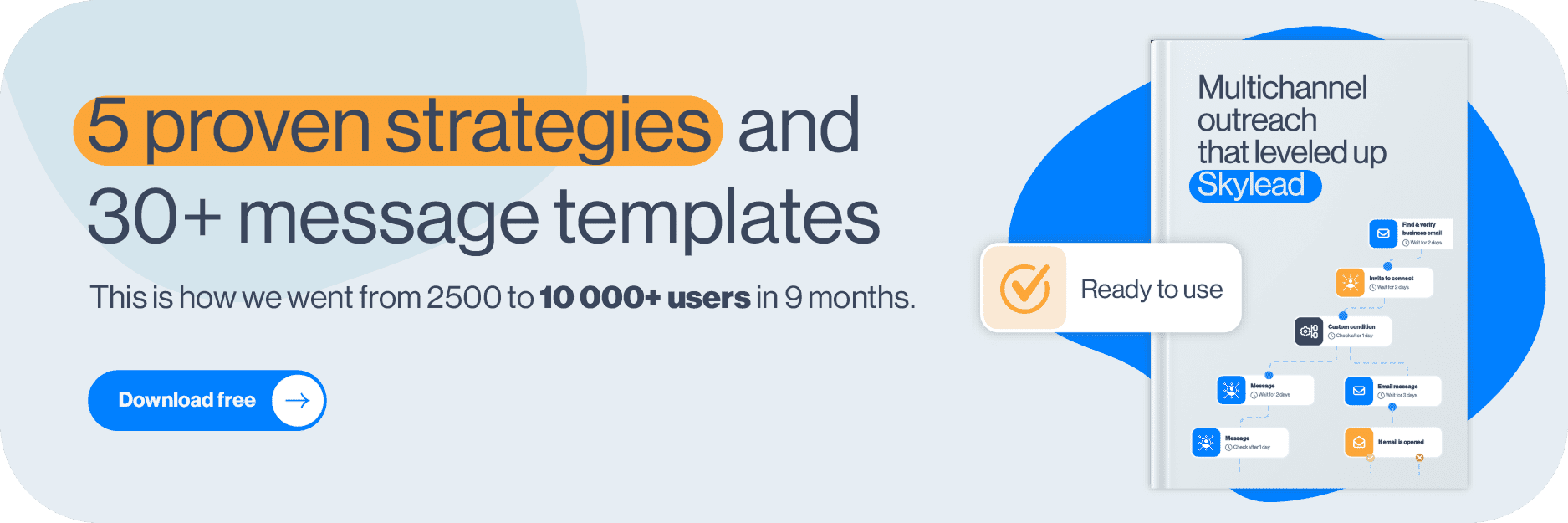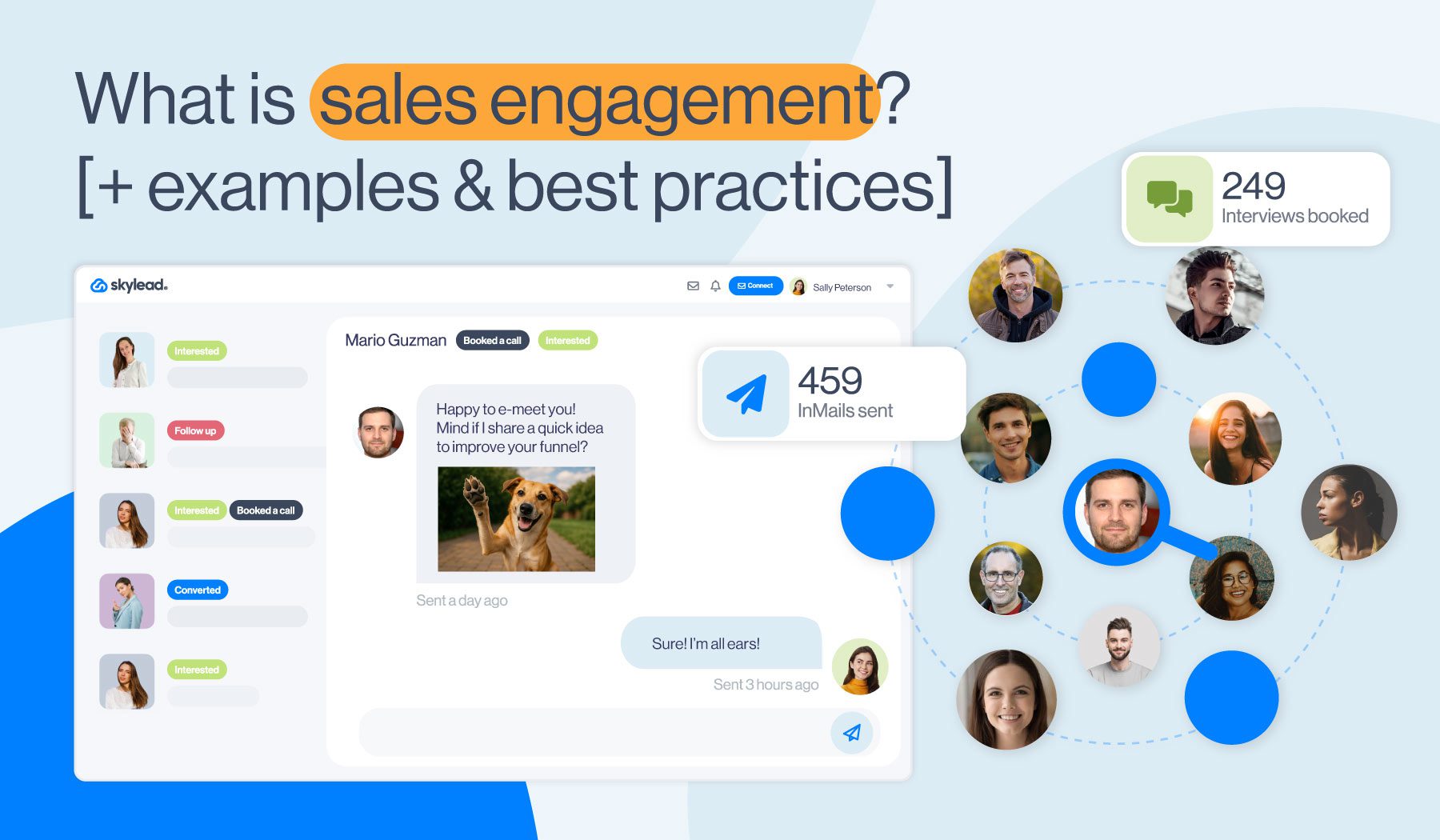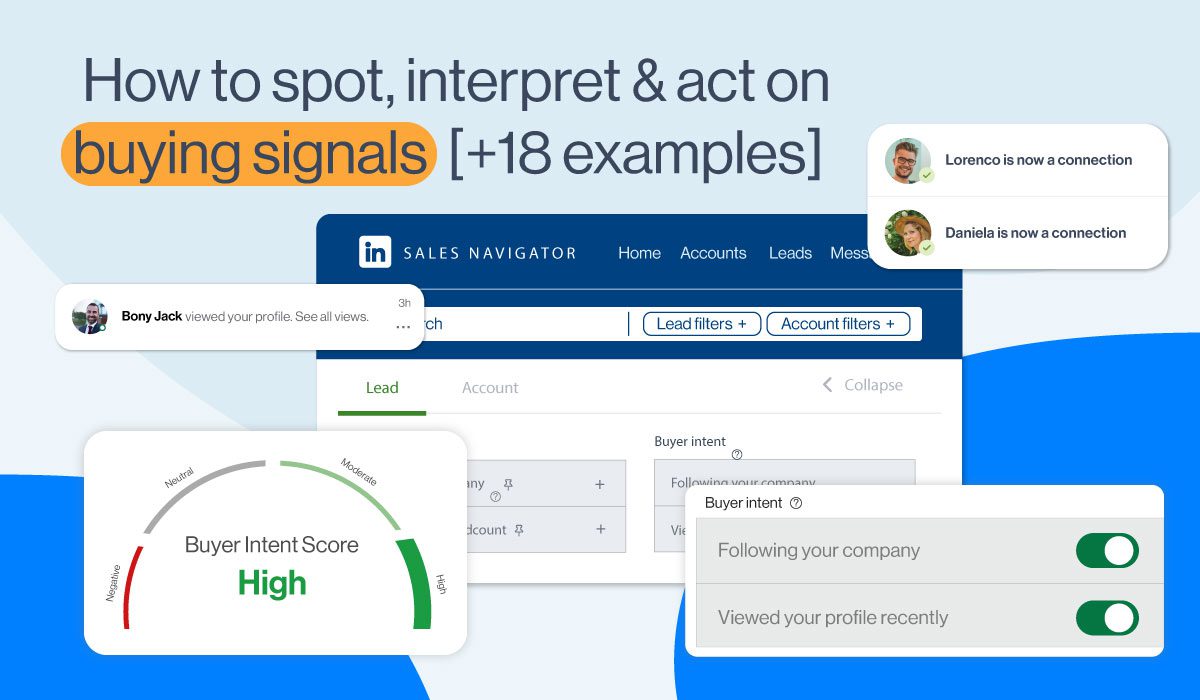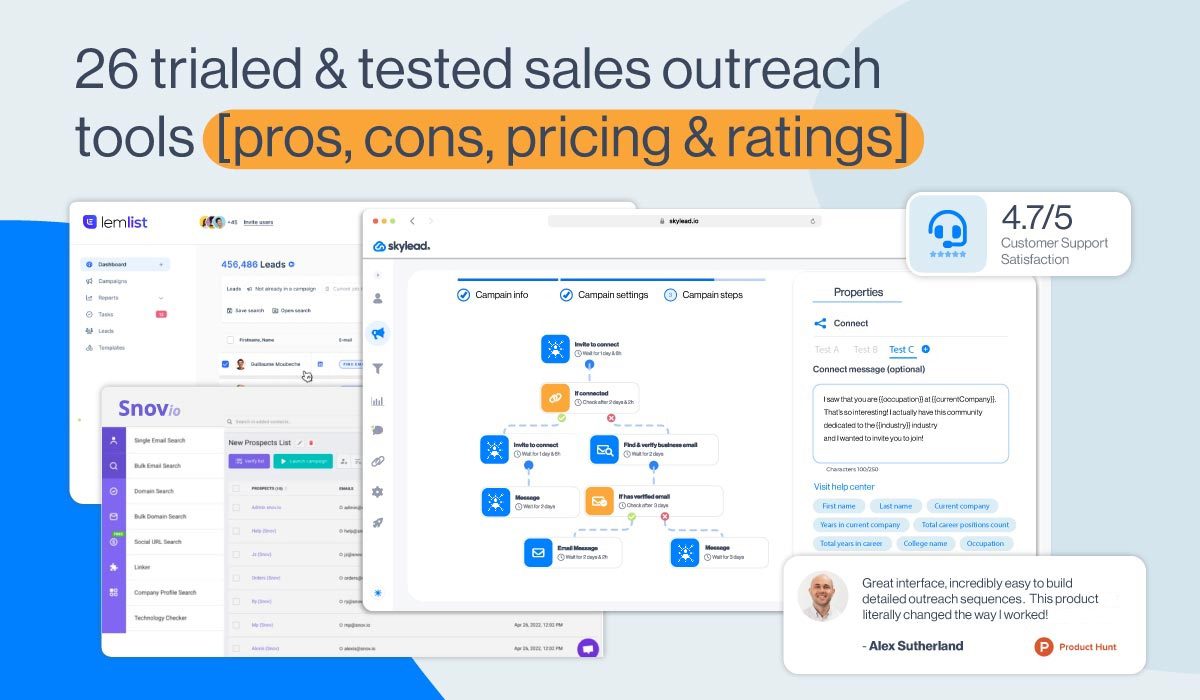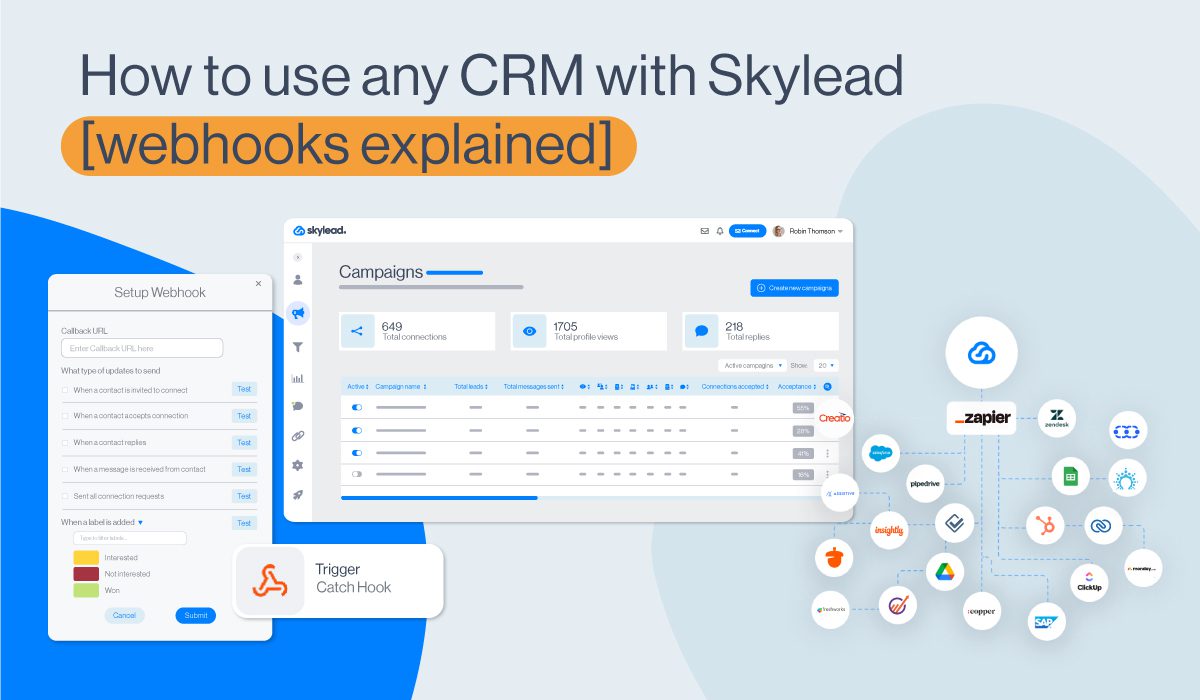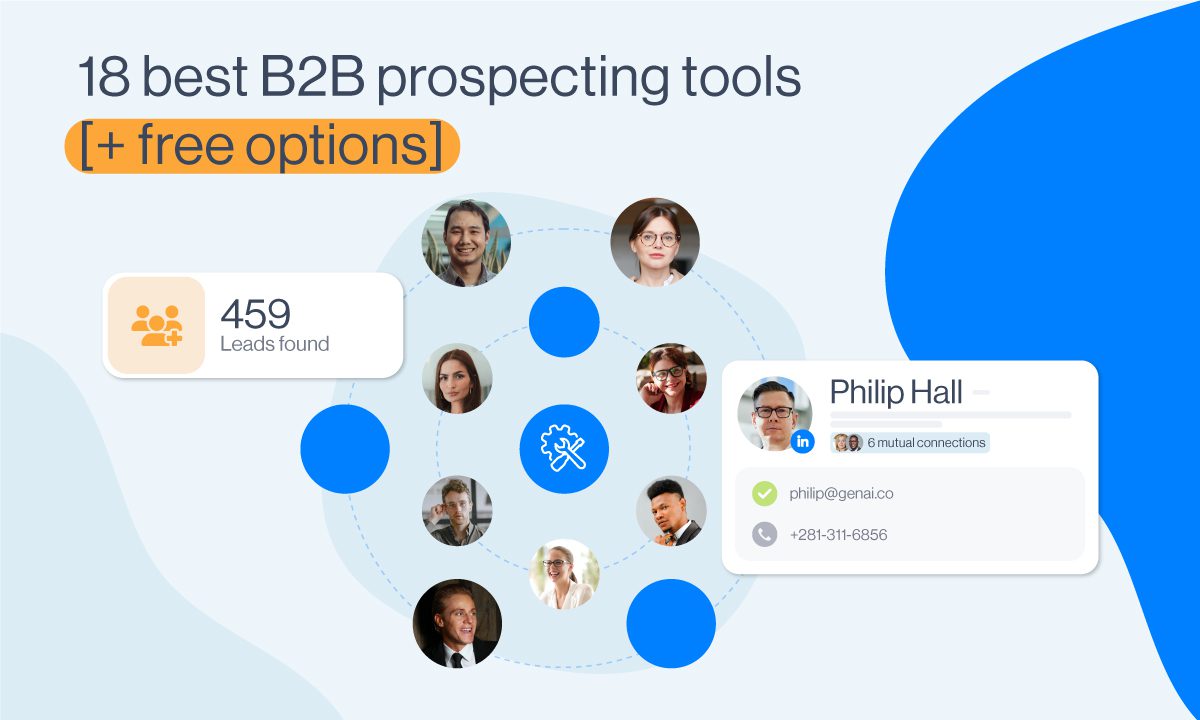How to build a sales meeting agenda that gets results [+3 templates]
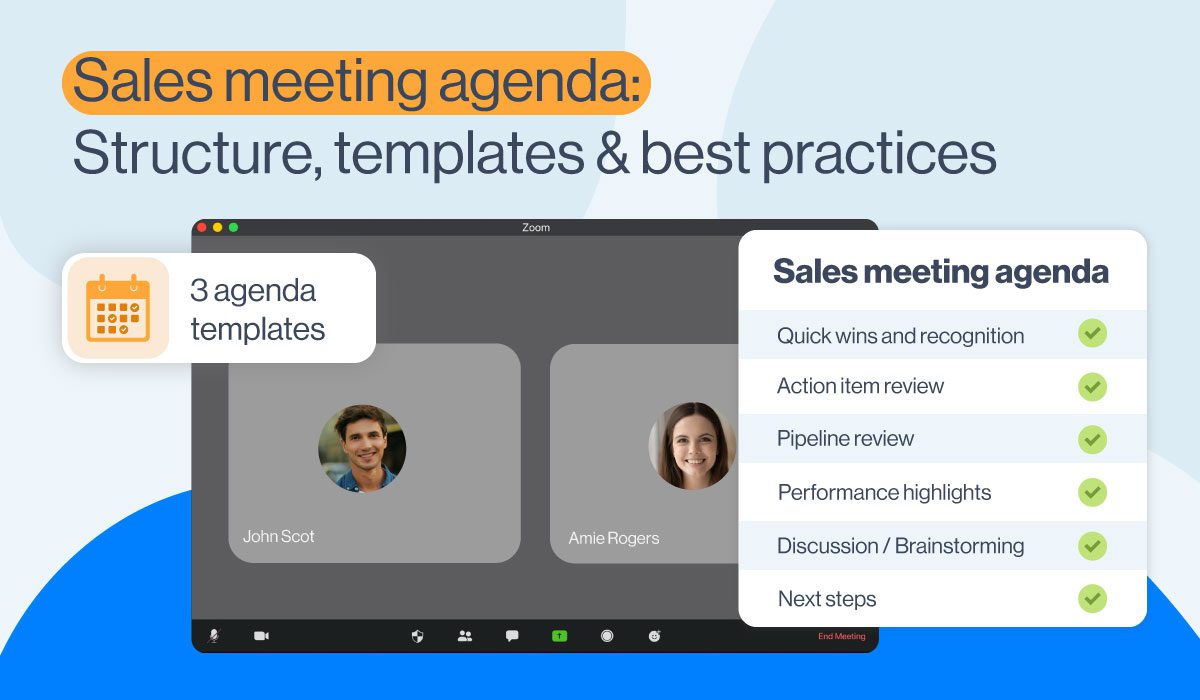
Have you ever left a meeting thinking, “This could have been an email”? Truth be told, we all have.
Most meetings go off the rails, not because the presenter isn’t capable, but because there’s no clear sales meeting agenda. This results in missed opportunities, zero alignment, and participants zoning out instead of speaking up.
A well-structured agenda turns that around. It gives your meetings purpose, keeps everyone focused, and makes sure they leave with clear takeaways.
That’s why we asked our sales team at Skylead to explain how they structure agendas that lead to meetings people actually want to attend, and are now sharing their 2 cents on:
- What a sales meeting agenda should include
- 7 steps to create one that actually works
- Best practices to make meetings feel - dare we say - productive
As a bonus, we’ll be throwing in free agenda templates you can plug into your next meeting.
And while the tips below are based on internal team syncs mostly, the same structure can also help you lead better sales conversations with clients - whether it’s a discovery call, demo, negotiation, or quarterly/annual business reviews.
Shall we?
What is a sales meeting agenda? [+ why you need one]
71% of senior managers believe meetings are unproductive and inefficient. Other statistics show that 65% of people feel they regularly waste time in meetings. Not to mention, 51% of employees regularly work overtime due to meeting overload, with 78% of them saying they are expected to attend so many meetings that it's hard to get their work done.
What does all of this tell you?
That the meeting itself isn’t the problem. The lack of structure is.
A sales meeting agenda acts like a map. It tells the participant(s) where you're headed, what’s worth discussing, and how to get there without taking detours. It keeps everyone aligned on goals, time, and ownership, helping meetings become a tool rather than a time drain.
As Patrick Lencioni, author of Death by Meeting, puts it:
“Bad meetings almost always lead to bad decisions, which is the best recipe for mediocrity.”
And the reverse is true too:
Good meetings - built on clear agendas - lead to better decisions, tighter alignment, and participants who actually want to show up the next time.
What should be included in a sales meeting agenda?
Now, what does a sales meeting agenda look like?
At its core, it’s a simple document - nothing fancy. You can outline it in a Google Doc, host it on Notion, or even write it down on a piece of paper if you're more old-school; it doesn't matter. As long as it’s structured, that is.
That being said, we asked our sales team what every sales meeting agenda should include, and this is what they told us:
- Clear objectives and goals
- Agenda items with time allocations
- Assigned presenters
- Discussion points
- Action items and follow-ups
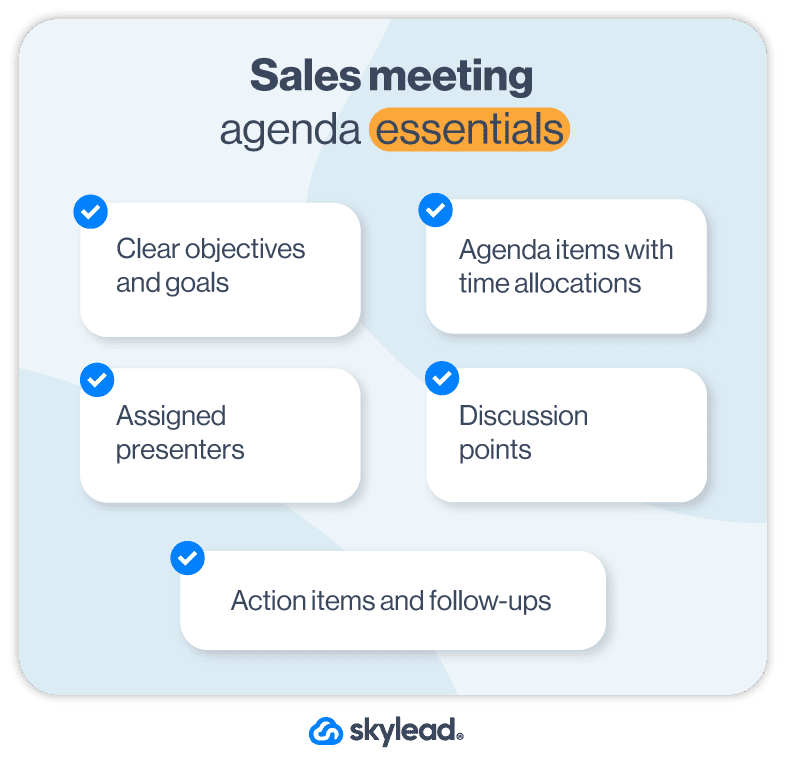
Types of sales meetings [+ internal & client-facing]
Salespeople don’t just attend internal meetings. In fact, most of the time, they spend in external meetings with leads, prospects, and clients.
That said, below is the breakdown of the most common sales meeting types, along with the role they play in the sales cycle.
Prospecting & discovery meetings
- Initial outreach - Connecting with new leads to spark interest and qualify fit.
- Discovery sessions - Uncovering a prospect’s challenges, goals, and the type of decision-making process.
Product & value-based meetings
- Demos - Walking prospects through the product, tailored to their needs.
- Proof of concept (POC) reviews - Validating technical fit or showcasing advanced functionality.
- Trial check-ins - Supporting leads who are actively testing the product.
Deal progression meetings
- Proposal discussions - Reviewing pricing, timelines, and next steps.
- Negotiation meetings - Aligning on terms, contracts, and expectations.
- Business decision-maker meetings - Engaging budget holders or executives to drive final buy-in.
Customer growth & retention meetings
- Quarterly or Annual Business Reviews (QBR/ABR) - Strategic check-ins to review performance and roadmap alignment.
- Renewal & expansion planning - Assuring satisfaction, identifying upsell/cross-sell opportunities.
Internal sales meetings
- Pipeline reviews - Syncing with sales managers to assess deal status and blockers.
- Account strategy sessions - Cross-functional alignment on high-priority accounts.
- Team huddles - Quick daily or weekly meetings to check in on goals, share updates, or raise immediate roadblocks.
- Sales performance reviews - Reviewing individual or team metrics, sales KPIs, and areas for improvement with leadership.
- Training & enablement sessions - Ongoing learning moments to sharpen product knowledge, objection handling, or sales techniques.
- Onboarding sessions for new reps - Introducing tools, processes, outreach templates, and team structure.
- Retrospectives or post-mortems - Reflecting on lost deals or campaign performance to identify what worked and what didn’t.
- Territory or quota planning meetings - Setting sales targets, reviewing coverage, or reassigning accounts.
📝 Note: No matter the type and whether internal or external, every meeting benefits from a clear agenda, especially when there are multiple stakeholders or big decisions on the table.
How to create a sales meeting agenda [7-step framework]
Now that you know the different sales meeting types and the main components of a great agenda, it’s time to learn how to use them to actually build one.
But instead of giving you a generic checklist, we’re sharing a framework our sales team coined and absolutely swears by.
They call it the SCAAPID framework: 7 steps to creating a sales meeting agenda that’s clear, efficient, and outcome-driven.
Here’s what the letters stand for:
- S - Set clear meeting objectives
- C - Choose relevant topics
- A - Assign roles & responsibilities
- A - Allocate time for each section
- P - Plan for engagement
- I - Include learning, feedback & training opportunities
- D - Define action items & next steps
Sounds good in theory, right? Let’s walk through how to actually implement each part.

1. Set clear meeting objectives
Before you think about topics, presenters, or time slots, ask yourself:
What’s the one thing this meeting needs to achieve?
Your objective is a filter for every item on the agenda. Without one, your meeting becomes a list of updates that could have been a Slack thread.
So, add your meeting objective as the very first line of the agenda doc. It sets expectations and keeps everyone honest about the purpose.
That said, a good meeting objective is:
- Specific (e.g., ''Identify top 5 stuck deals and define next steps,” instead of “Talk about pipeline.”
- Relevant - Tied to your sales cycle, metrics, or current roadblocks.
- Outcome-driven - It leads to a decision and/or action.
Here are a few examples to paint a better picture:
| Sales meeting type | Strong objective |
| Weekly team meeting | Review the top 3 pipeline risks and agree on next steps for each. |
| Quarterly sales planning | Define 3 strategic focus areas and assign owners for Q1 execution.” |
| Onboarding new reps | Introduce tools, set onboarding KPIs, and walk through outreach templates. |
| Discovery meeting | Uncover the prospect’s top challenges, timeline, and buying process. |
| Demo | Show how the product solves the prospect’s pain points and confirm next steps. |
| Follow-up / Proposal call | Address final questions, review pricing and terms, and move toward verbal agreement. |
2. Choose relevant topics
Once you’ve nailed your objective, the right topics will almost pick themselves. That’s because your objective naturally narrows the scope.
Say your objective was to identify stuck deals. Then it makes sense to focus on pipeline reviews, stage-specific blockers, and next steps - not pricing updates.
When in doubt, ask yourself:
- Does this topic help us hit our meeting goal?
- Is this the right audience for this topic?
- Will this lead to a decision or the next step?
In other words, instead of thinking about what the meeting should talk about, think:
What will help us accomplish the meeting objective?
For example, if you're preparing for a demo call with a prospect who's evaluating multiple tools, topics like “feature overview” or “UI walkthrough” might sound relevant, but they only help if they’re tied to the pain points uncovered in discovery.
So, instead of a generic demo, focus on use cases that matter to them (e.g., automation, reporting, integrations, etc). That’s what will actually move the deal forward.
3. Assign roles & responsibilities
Every internal sales meeting should have clearly assigned roles to keep things efficient, on track, and actionable.
It's simple, really. If no one owns the meeting, it's bound to drag, derail, or result in...well, nothing.
On the other hand, when everyone knows their role, the meeting runs like clockwork, and more importantly, leads to real outcomes.
In terms of roles, you'll need a:
- Facilitator - to keep the meeting focused and transition between topics. That's typically the sales manager or whoever called the meeting.
- Presenter(s) - owns specific agenda items. Can be an SDR, account manager, anyone who’s responsible for that topic, really.
- Note-taker - responsible for capturing notes and sharing them post-meeting. Though these days, tools and extensions can automate this role.
- Timekeeper - useful for packed agendas. Helps keep each section within time.
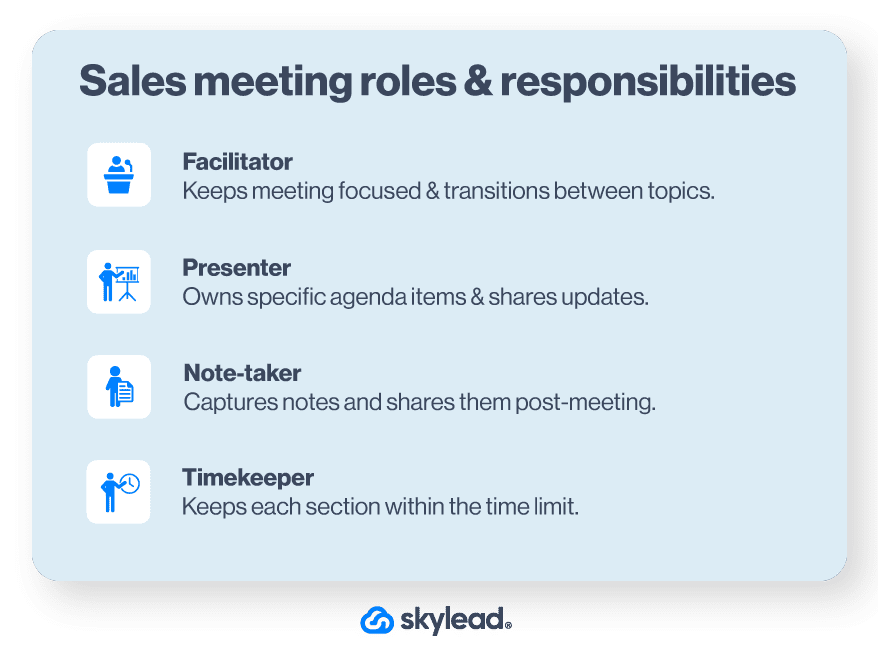
Roles look a bit different in external or client-facing meetings. You likely won’t assign a “timekeeper” or “note-taker” in front of the client, and often, these meetings are 1-on-1 between the rep and the buyer. But that doesn’t mean roles don’t matter.
Behind the scenes, you’ll still want to prep who’s leading the conversation, who’s owning the follow-up, and what materials or demos are being presented.
Not to mention, throughout their lifecycle, the client may interact with different people across your organization, from SDRs to account executives to the customer success team. That’s why having clarity on who’s responsible for what is important. After all, it’s what makes for a smooth and consistent buyer experience.
📝 Note: Add names next to agenda items ahead of time, so everyone comes prepared and nothing slips through the cracks.
4. Allocate time for each section
Raise your hand if you’ve ever been in a meeting that was supposed to take 30 minutes... but somehow stretched to an hour and a half.
Yeah, us too.
That’s what happens when you don’t assign time to topics. One section gets too much airtime, someone goes on a tangent, and - before you know it - you’ve spent 45 minutes dissecting one missed deal while everything else gets rushed or skipped.
The fix? Add time blocks to each agenda item. It doesn’t have to be exact to the minute, but it should give everyone a sense of how much breathing room each part has.
A few rules of thumb:
- Prioritize based on the meeting objective.
- Cap open discussions (they’ll expand if you let them).
- Leave 5 minutes at the end to recap and lock in next steps.
This applies just as much to external meetings as it does to internal ones.
Let’s say you’re running a 30-minute demo with a prospect. Without a rough time structure, you might spend too long on general features they don’t care about and run out of time before you get to the part they actually need.
Instead, aim for something like:
- 5 minutes: Quick recap of their use case
- 15 minutes: Focused product walkthrough
- 5 minutes: Q&A
- 5 minutes: Next steps
And if something needs more time? It probably deserves its own meeting.
5. Plan for engagement
A common mistake in sales meetings is treating them like a one-way update. Someone talks, others nod, and 30 minutes later, the meeting’s over, with little input or discussion.
The thing is, the best sales meetings are joint sessions where all members (or the majority of them) actively participate.
But if you want people to participate, you need to make space for it - in the agenda AND in the way the meeting is run.
Here are a few ideas on how to make that happen.
How to get teammates to participate in internal meetings
Start with quick wins
Kick things off on a high note by dedicating the first few minutes to celebrating something, such as a:
- Deal that moved forward unexpectedly
- Great objection handling moment
- Creative email subject line that got a hard-to-reach prospect to reply
- Milestone hit by the team (quota, response rate, etc.)
These celebrations not only energize the room but also create a culture where small wins are seen and shared.
You’d be surprised by how often this sets the tone for an open, productive meeting.
Make space for open discussion
Not everything can (or should) be scripted. That said, reserve 5-10 minutes toward the end for open conversation. This can be guided by a prompt like:
- What’s one challenge you’re currently facing?
- Anything you need help with this week?
- Any learnings worth sharing with the group?
- etc.
The goal isn’t to force people to speak, but to give them a chance to.
Add a moment of recognition
Don’t finish the meeting until you’ve acknowledged someone’s effort. Even if it’s just a minute, a quick shoutout for a solid follow-up email after no response, a killer cold outreach message, helping a teammate, or anything else for that matter, is worth calling out.
It signals that showing up and doing the work doesn’t go unseen. And over time, it builds a culture where people feel genuinely appreciated.
This matters a lot more than you may think. In fact, people rarely leave their jobs because of the work itself. They leave because they feel invisible. Numbers-wise, 66% of employees say they’d leave their jobs if they didn’t feel appreciated. Thus, a bit of recognition in each meeting can go a long way in keeping your team around.
How to keep participants engaged in client-focused meetings
Client-facing meetings are a little different. You don’t need icebreakers or shoutouts; you just need to avoid turning it into a lecture. The best way? Get them involved early and often.
Try this:
- Ask open-ended questions throughout - Instead of presenting for 20 minutes straight, pause to ask: “How does this process work in your team today?” or “Would this help solve the bottleneck you mentioned earlier?”
- Let their answers guide the flow - If they lean into a certain feature or use case, spend more time there instead of going through a generic demo.
- Leave space for objections - Don’t save all questions until the end. Build in time for them to raise concerns so you can handle them in real time.
- Summarize and check for alignment - Every few minutes, recap what you’ve covered and confirm if it lines up with what they were hoping to see.
The more your buyer participates, the more invested they feel, and the closer you are to landing the next step.
6. Include learning, feedback & training opportunities
Most people focus on numbers and next steps, but forget that every meeting is also a chance to level up. Without space for learning or reflection, meetings become routine recaps; useful, sure. But transformative? Not really.
So, carve out a few minutes for learning, shared insights, or feedback.
It doesn’t have to be formal. In fact, the more rep-driven and practical it is, the better. Think of it as peer-to-peer knowledge sharing that sharpens the team’s sales tactics and builds a culture of continuous improvement.
And when it comes to external meetings, don’t overlook them as learning moments, either. A simple question, such as “Was this helpful?” or “Is there anything you’d like us to go deeper on next time?” shows you care and gives you feedback you can use to improve future meetings.
7. Define action items & next steps
You’ve had the meeting. Topics were discussed. Heads nodded. People participated. Great. But what happens afterwards?
If there’s no clear follow-up, all that alignment and input quickly fades, and you’re back at square one.
That’s why every meeting should end with defined action items. Who’s doing what? By when? How will progress be tracked?
Here’s a simple format we like:
- Action - What needs to be done?
- Owner - Who’s responsible?
- Due date - When will it be done?
…and what that looks like in real life:
- Action: Send follow-up emails to new leads
- Owner: Priya
- Due date: Friday
After the meeting, send a quick summary to the participant(s) (email, Slack - whatever works best). This keeps responsibilities clear, reinforces accountability, and gives everyone a handy reference.
Sample sales meeting agenda templates
Not all sales meetings are created equal, as you’ve seen.
For this reason, we've created 3 agenda templates: 1 general for internal purposes and 2 designed for client-facing meetings. Use them as a starting point and adjust accordingly.
1. Internal sales team meeting agenda
Frequency: Monthly, Quarterly, or Annually
Duration: 45-120 minutes (depending on scope)
Attendees: Sales reps, managers, leadership, and cross-functional stakeholders
Presenters {By role and name}:
| Section | Details | Time allocation |
| Welcome & context | Review performance since last meeting, set agenda | 5-10 min |
| KPI & pipeline review | Deal health, metrics, and progress on targets | 10-20 min |
| Strategic priorities | Key focus areas for next period (campaigns, markets, accounts) | 10-20 min |
| Team feedback & challenges | Gather input, identify blockers | 10-15 min |
| Learning / Training moment | Peer knowledge share, enablement session, or guest speaker | 10-15 min |
| Action plan & ownership | Assign tasks, define deadlines, confirm accountability | 10-15 min |
| Recognition & wrap-up | Celebrate wins, confirm goals, and outline next meeting | 5-10 min |
2. Demo meeting agenda
Frequency: As scheduled with prospects
Duration: 30-45 minutes
Attendees: Account executive / Sales rep + Prospect(s)
Presenters {By role and name}:
| Section | Details | Time allocation |
| Introductions & context | Quick rapport-building, confirm agenda and prospect’s goals | 5 min |
| Recap of needs | Confirm key pain points uncovered in discovery | 5 min |
| Tailored product walkthrough | Demo features relevant to their challenges | 15-20 min |
| Q&A | Address questions, explore objections | 5-10 min |
| Next steps | Align on follow-up (trial, proposal, second demo) | 5 min |
3. Follow-up / Proposal meeting agenda
Frequency: After demo or late-stage in sales cycle
Duration: 20-30 minutes
Attendees: Account executive / Sales Rep + Prospect(s) / Decision-makers
Presenters {By role and name}:
| Section | Details | Time allocation |
| Recap of previous meeting | Summarize what was covered and agreed on | 3-5 min |
| Proposal / Pricing review | Walk through proposal details, pricing, and terms | 10 min |
| Objection handling | Address concerns, clarify expectations | 5-10 min |
| Next steps | Confirm decision process, timeline, and follow-up actions | 5 min |
Best practices for running effective sales meetings
Even with the best agenda, how you run the meeting matters just as much.
Below are some tried-and-tested habits to make your sales meetings more effective.
Send the agenda in advance
Don’t make people walk into the meeting blind. Share the agenda at least 24 hours in advance so attendees have time to prepare, especially if they’re presenting or expected to contribute.
As for where to send it? Whatever you already use - Slack, email, Notion, a shared doc. Just make sure it's accessible and linked in the calendar invite.
Set ground rules
When running internal sales meetings, simple ground rules go a long way in making them more productive.
Some examples:
- Cameras on (if you’re remote)
- One person talks at a time
- Keep updates under 2 minutes
- No multitasking (Slack, inbox, etc.)
Set the tone upfront, and remind people as needed. A few expectations agreed on early can save a lot of time (and eye rolls) later.
Stay on track and respect time
Use your agenda as a guide, not a suggestion. Keep an eye on time allocations and gently move things along if a topic is dragging. If something important comes up but doesn’t fit the flow, take note and spin it off into a follow-up - or another meeting.
Time boundaries matter even more in external meetings. If you say the call will take 30 minutes, make sure it does. Prospects often have back-to-back meetings, and going over can leave a bad impression or cut into the most important part of your pitch.
Only schedule meetings when necessary
Some meetings should really be emails.
That said, if the goal is to share information, give status updates, or report numbers that don’t require discussion, don’t book one.
Save meetings for when real-time collaboration or decision-making is truly needed. Otherwise, you're just eating into everyone's deep work time.
Sales meeting effectiveness checklist
Want to know if your sales meeting agenda is actually working? Don’t guess - track it!
Here’s a simple checklist you can revisit after each meeting for assessment:
Pulse check
- Did attendees feel the meeting was a good use of time?
- Was there feedback on how to improve it next time?
(Use a quick Slack poll or ask during wrap-up.)
Action follow-through
- Were action items clearly defined (owner + due date)?
- Were those action items completed by the next meeting?
- Did the meeting move deals forward or solve real blockers?
Engagement
- Did multiple team members contribute or ask questions?
- Was there an open discussion or knowledge sharing?
- Were people focused (no multitasking, cameras on, etc.)?
Meeting quality
Give a quick 1-5 rating on these:
- Clear objective
- Time managed well
- High participation
- Useful takeaways
- Concrete next steps
If you’re seeing a lot of ❌s or low scores, it’s a signal to adjust the agenda, tighten the structure, or switch up the format.

Frequently asked questions
What are the 4 P's of a meeting agenda?
The 4 P’s typically stand for Purpose, Product, People, and Process. They help ensure your meeting has a clear objective (Purpose), produces tangible outcomes (Product), involves the right stakeholders (People), and follows a structured flow (Process).
What should be included in a sales meeting agenda?
A strong sales meeting agenda should include clear objectives, key topics with time allocations, assigned roles or presenters, discussion points, space for feedback and learning, and defined action items and next steps.
Who is responsible for creating the sales meeting agenda?
Typically, the person running the meeting should own the agenda, which is most often the sales manager or rep leading the call.
How detailed should the agenda be?
Enough to set clear expectations, but not so detailed that it overwhelms. Include objectives, topics, time estimates, and owners. If extra context is needed, link to supporting docs rather than dumping everything into the agenda.
What tools should I use to create and manage sales meeting agendas?
Whatever your team already uses. Common tools include:
- Notion or Confluence for shared docs
- Google Docs or Sheets for collaborative agendas
- Asana, ClickUp, or Trello to track post-meeting tasks
- Slack or email for agenda distribution and follow-ups
How can I make sure every person stays engaged during internal sales meetings?
Assign them to lead different parts of the agenda, ask for input often (e.g., quick polls or round robins), and include open floor or recognition segments. Engagement often comes down to participation.
What’s the best way to follow up after a sales meeting?
Send a short summary that includes the key takeaways, action items, and deadlines. Use Slack, email, or whatever your go-to channel is. This keeps everyone accountable and ensures next steps don’t fall through the cracks.
Set your sales meetings up for success
A good sales meeting gives you clarity, alignment, and energy to tackle the next challenge. And it all starts with a clear sales meeting agenda.
So, take the templates, adopt the SCAAPID framework, try the best practices, and adjust them accordingly. Because when your meetings run better, you perform better.
And if you want more to report on (and brag about) in your next internal sales meeting, Skylead can help. Our sales engagement platform helps you book 3x more meetings with prospects in less time.
Sign up for a 7-day free trial today and show up to your next meeting with results worth talking about!



